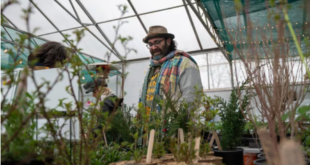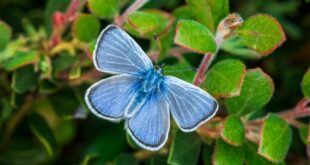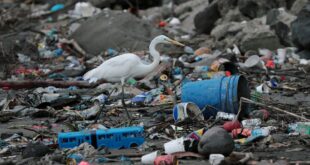Also: An underwater art exhibit.

Our planet is changing. So is our journalism. This weekly newsletter is part of a CBC News initiative entitled “Our Changing Planet” to show and explain the effects of climate change. Keep up with the latest news on our Climate and Environment page.
Sign up here to get this newsletter in your inbox every Thursday.
This week:
- Ancient Indigenous ‘clam gardens’ could be modern-day climate solution
- Diving into an underwater art exhibit
- Is a forest with a variety of tree species better at fighting climate change?
Ancient Indigenous ‘clam gardens’ could be modern-day climate solution

For close to four centuries, “clam gardens” on beaches on the west coast of B.C. have provided First Nations with a supply of not just clams but other types of seafood.
In the aftermath of the brutal 2021 heat dome on the West Coast, there’s renewed interest in this ancient aquaculture technique.
Five days of stifling heat killed hundreds of people and billions of sea creatures. But scientific experimentation by researchers from Simon Fraser University, in collaboration with Coastal Salish First Nations, indicates clam gardens help sea life stay cooler.
The research aims to show how ancient Indigenous practices offer a modern-day solution to coping with climate change.
SFU master’s student Emily Spencer wanted to know whether the clam gardens, with their steady supply of cool water, could help keep shellfish cooler and protect them from future episodes of extreme heat.
Ken Thomas was more than willing to demonstrate the age-old practices of maintaining clam gardens on a recent visit to Russell Island, which lies close to the better-known Saltspring Island, off the southeast coast of Vancouver Island.
He’s intimately involved with the research being carried out here. A tall, broad-shouldered man in his 50s, Thomas is in charge of fisheries, wildlife and natural resources for the Penelakut First Nation.
He picked up a three-pronged rake and began “tilling” the sand. As he pulled the rake down, he explained that it helps keep the beach from becoming “hard and dormant.” It also revealed small clams and crabs living close to the sand’s surface.
When the idea of reconstructing a clam garden on this beach was broached a few years ago, Thomas wasn’t convinced. Elders directed him and others to pick up large rocks from higher up the shore and arrange them to form a rough seawall close to the low tide line.
“At first it was, ‘OK, yeah, I’ll go move rocks, whatever,'” Thomas told What On Earth. But something shifted in him as he heard the elders tell stories from the past. He began to understand and appreciate how a technique so old could work so well for him and his children.
“It really touched me in a way that I can’t explain,” Thomas said. “Every time I moved a rock and placed it on the wall, I was like, wow, my ancestors touched these rocks, and here I am putting it back, restoring it back to what it was meant for.”
The rock wall is about a metre and a half tall and runs the length of the beach, about 750 metres. It ensures that ocean water recedes slowly as the tide goes out, maintaining a cool, wet environment until the tide comes back in. That makes the beach a kind of shelter or refuge — or pantry, according to Thomas’s forebears.
“To this day, you still hear our elders saying, ‘When the tide’s out, the table’s set. Go get your food.'”
Working with Thomas to ensure Indigenous knowledge and practices are respected, Spencer designed an experiment that used Ikea chairs, propane torches and non-flammable material to recreate the conditions of the heat dome on the beach. “We created little saunas for the clams,” she said.
At low tide, they erected a series of these small tents with the clams inside. They did this for five days straight — replicating the length of the heat dome. After that, the clams were scooped up and taken to labs for analysis.
Spencer’s results — to be submitted for peer review in the coming months — found the gardens kept the clams cooler even with the added heat.
This effect suggests the gardens are more than a way to create and maintain a food source. They could also be a climate adaptation strategy for an entire ecosystem.
Spencer’s supervisor at SFU, marine ecologist Anne Salomon, is excited about the prospect.
“We’re desperately looking around the world for climate solutions, and here’s one that is at least 4,000 years old,” Salomon said. “It works. It’s a very simple process, and so I am very optimistic about the future when I see examples like this.”
For Ken Thomas, it’s confirmation that his people knew how to use the resources responsibly for millennia. That’s one reason he so readily agreed to go ahead with Spencer’s experiment.
“Just last night, we had a nice pot of steamers, manila clams and little neck clams [to eat]. So you know, we still utilize it and we still love it and we want it around forever.”
– Laura Lynch
Old issues of What on Earth? are here. The CBC News climate page is here.
Watch the CBC video series Planet Wonder featuring our colleague Johanna Wagstaffe here.
Reader feedback
Joanne Moyer:
“Thank you so much for your hard work telling compelling climate stories. I teach environmental studies at a small university in Edmonton and I’ve been getting great ideas for stories to integrate into my teaching from your newsletter ever since I signed up for it. I also listen to CBC Radio regularly and have had an idea brewing for a while, though I wasn’t sure how to suggest it. Maybe you’re the people!
“In the morning, on the local CBC Radio show, there are regular reports on sports, economics and other things like that. Surely, given the state of today’s environment, we should also be getting regular environmental/climate reports in the same way. While your show and newsletter are great, they are things that people who are really interested are going to sign up for or listen to. Short reports that put the environment on the same level of importance as the economy and hockey are going to reach everyone, however, and help normalize thinking about how we are connected to the ecological systems, and how our actions as individuals and in society affect them.”
Write us at whatonearth@cbc.ca. Have a compelling personal story about climate change you want to share with CBC News? Pitch a First Person column here.
The Big Picture: An underwater art exhibit

June 8 is World Ocean Day, when we reflect on the ecological importance of our oceans and raise awareness about the measures needed to protect them from climate change and biodiversity loss. British artist Jason deCaires Taylor is marking the day with an ethereal exhibit down inside Australia’s Great Barrier Reef, the largest coral reef in the world. Rising temperatures related to climate change have led to a number of mass bleaching events in the reef, which have greatly damaged the coral.
The display, entitled Ocean Sentinels, is being hosted by the local Museum of Underwater Art and features an array of submerged statues. Made from “Earth-friendly concrete” (according to the museum), these surreal, serene objects are totems to specific scientists who have worked to protect the Great Barrier Reef. Suffice to say, the exhibition is best viewed while scuba diving or snorkelling.
This isn’t deCaires Taylor’s first attempt at aquatic art — in 2019, he sank a number of statues elsewhere off the coast of Australia for an exhibition called Coral Greenhouse. He says his intent, then as now, was to make the statues friendly to marine life, so that corals, sponges and other creatures would change them in “vibrant and unpredictable ways.”
Hot and bothered: Provocative ideas from around the web
- Wildfire smoke has shrouded most of the country this week. Here’s an explainer on what you can do to stay safe during these hazy days.
- Some opinion writers have argued that taking action against climate change in Canada is pointless because our country produces so few emissions compared to China. The Observer’s Max Fawcett takes a closer look at that argument, finding that China is storming ahead on climate action — and Canada could be left behind.
- World leaders, scientists and advocates are working to negotiate a treaty that aims to tackle the global plastic pollution problem. Under discussion are cuts to plastic production, bans on certain materials and products including many single-use plastics and incentives to grow an industry around reusable items.
- San Francisco requires new large buildings to have water recycling systems so drinking water isn’t used for things like flushing toilets. Now, amid water shortages, “extreme decentralized” water recycling is taking hold in other states, as well as with Japan, India and Australia.
- Scientists have found a new way to track biodiversity and biodiversity loss: by looking for DNA of plants and animals in air filters used to monitor pollution.
Is a forest with a variety of tree species better at fighting climate change?

Planting trees is often a go-to action for environmental sustainability, but it turns out that it really matters what types of trees you plant — and where.
Tree diversity, or the amount and distribution of tree species in a forested area, is critical for growth, sustaining biodiversity and building resilience to the effects of climate change.
A new study shows it also makes a big difference in the carbon cycle — that is, the balance created by carbon being absorbed by ecosystems and then returned to the atmosphere through decomposition.
Unfortunately, tree diversity is on the decline on a global scale, and is a particular problem in Canada.
“In Canadian forests, as compared to temperate and tropical forests, tree diversity is low,” said Scott Chang, a professor of renewable resources at the University of Alberta.
But around the world, tree diversity “has been decreasing due to human interference, global climate change, harvesting of forests and so forth,” he added.
Tree diversity is a term used to describe three specific qualities in our forest environment, according to Chang.
The first two qualities are species richness, which is measured by the number of trees in an area, and evenness, which Chang describes as how equally the species are distributed.
The last factor comes down to the actual trees and the different functions they perform in a forest.
“Some of them have bigger leaves, some have small leaves, and those are a measure of function,” Chang said.
Different species of trees have distinct physical characteristics; in turn, those characteristics give them different capacities to adapt to certain challenges. And that ensures the forest is resilient to stress, said Devon Earl, an environmental scientist and conservation specialist with the Alberta Wilderness Association.
While maintaining forest biodiversity helps to improve resilience to climate change, diversity can also help mitigate further warming, according to a new study published by Naturein April on carbon storage in natural forests across Canada.
“This is the first study to demonstrate that tree diversity can increase soil carbon sequestration in natural forests,” said Chang.
The study looked at data over an almost 20-year period, and included hundreds of forest plots scattered across the country.
According to the study, increasing species evenness increases soil carbon and nitrogen by 30 and 42 per cent, respectively.
Increasing the functional diversity — that is, the variety of physical characteristics within the forest — enhanced soil carbon and nitrogen by 32 and 50 per cent, respectively.
“More diverse trees can uptake more carbon dioxide from the atmosphere that will mitigate the global change, and also it could … reduce nitrogen loss from the forest,” said Xinli Chen, a post-doctoral student and lead author on the study.
Chen said that more diverse forests often have more biomass production. Factors like root depth and canopy height play a role in how forests grow and thrive, he added.
“They can take more resources from the ecosystem,” he said. “So this means they can grow better … and it means they can take more carbon from the atmosphere.”
Chang said the study opens the door for embracing tree diversity as a means of climate change mitigation in Canada. He said the implications from this research should be implemented in the Canadian government’s “2 Billion Trees Commitment,” an initiative that is working to help organizations plant two billion trees in Canada over the next decade.
“If they can use multiple tree species for instructing those tree plantings instead of just a single tree species, there is a potential benefit that can be gained to increase carbon sequestration,” Chang said.
According to Earl, after an area is logged, forestry companies tend to plant a single species that they want to cut again in the future. In addition, she said, companies will often use the herbicide glyphosate to suppress the growth of deciduous trees and other plants.
“They just want to have that one species of tree growing back that they want to harvest again, and they don’t want that tree species to have any competition for things like light and soil nutrients,” she said.
Earl explained that allowing those deciduous trees to grow in replanted cutblocks benefits the wildlife but also helps with the increased risk of wildfire as our climate changes.
Deciduous trees such as aspen are less likely to burn, and when they do, they burn less intensely.
“It’s really important to have these trees in the forest that are less likely to burn intensely and can act as sort of a break.”
– Christy Climenhaga
Stay in touch!
Are there issues you’d like us to cover? Questions you want answered? Do you just want to share a kind word? We’d love to hear from you. Email us at whatonearth@cbc.ca.
Editor: Andre Mayer | Logo design: Sködt McNalty
*****
Credit belongs to : www.cbc.ca
 Atin Ito First Filipino Community Newspaper in Ontario
Atin Ito First Filipino Community Newspaper in Ontario






